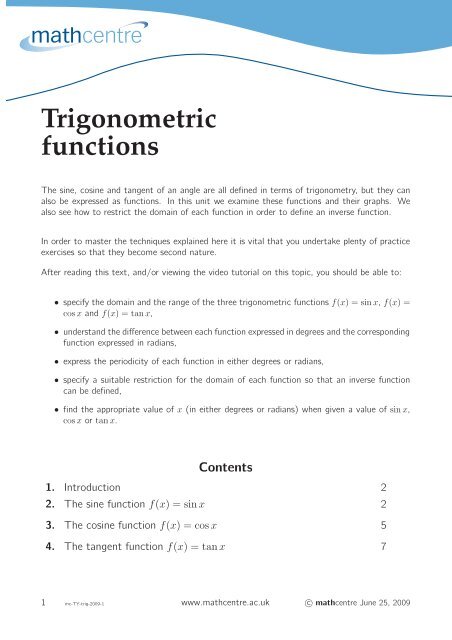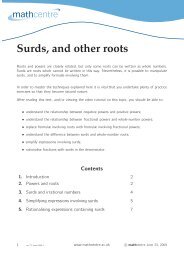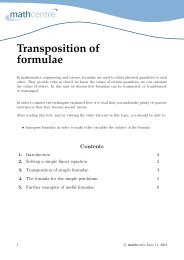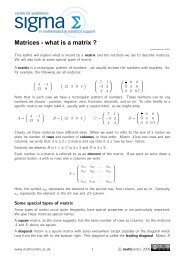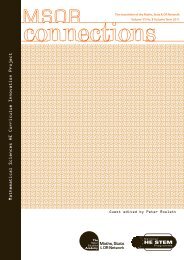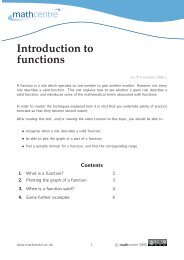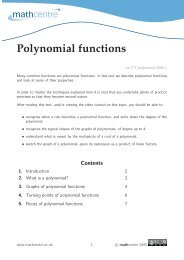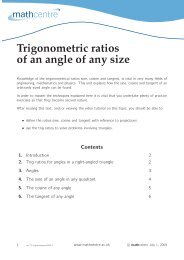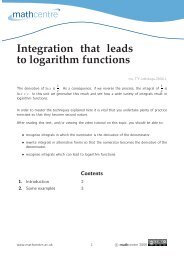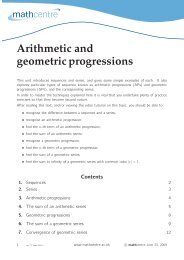Trigonometric functions - Mathcentre
Trigonometric functions - Mathcentre
Trigonometric functions - Mathcentre
Create successful ePaper yourself
Turn your PDF publications into a flip-book with our unique Google optimized e-Paper software.
<strong>Trigonometric</strong><strong>functions</strong>Thesine,cosineandtangentofananglearealldefinedintermsoftrigonometry,buttheycanalsobeexpressedas<strong>functions</strong>. Inthisunitweexaminethese<strong>functions</strong>andtheirgraphs. Wealsoseehowtorestrictthedomainofeachfunctioninordertodefineaninversefunction.Inordertomasterthetechniquesexplainedhereitisvitalthatyouundertakeplentyofpracticeexercisessothattheybecomesecondnature.Afterreadingthistext,and/orviewingthevideotutorialonthistopic,youshouldbeableto:•specifythedomainandtherangeofthethreetrigonometric<strong>functions</strong> f(x) = sin x, f(x) =cosxand f(x) = tanx,•understandthedifferencebetweeneachfunctionexpressedindegreesandthecorrespondingfunctionexpressedinradians,•expresstheperiodicityofeachfunctionineitherdegreesorradians,•specifyasuitablerestrictionforthedomainofeach<strong>functions</strong>othataninversefunctioncanbedefined,•findtheappropriatevalueof x(ineitherdegreesorradians)whengivenavalueof sin x,cosxor tanx.Contents1. Introduction 22. Thesinefunction f(x) = sinx 23. Thecosinefunction f(x) = cosx 54. Thetangentfunction f(x) = tanx 71 mc-TY-trig-2009-1 www.mathcentre.ac.uk c○mathcentreJune25,2009
1. IntroductionInthisunitweshalluseinformationaboutthetrigonometricratiossine,cosineandtangenttodefine<strong>functions</strong> f(x) = sin x, f(x) = cosxand f(x) = tan x.2. The sine function f(x) = sinxWeshallstartwiththesinefunction, f(x) = sin x.Thisfunctioncanbedefinedforanynumberxusingadiagramlikethis.sin xx1Wetakeacirclewithcentreattheorigin,andwithradius1. Wethendrawalinefromtheorigin,at xdegreesfromthehorizontalaxis,untilitmeetsthecircle,sothatthelinehaslength1.Wethenlookattheverticalaxiscoordinateofthepointwherethelineandthecirclemeet,tofindthevalueof sin x.Theinformationfromthispicturecanalsobeusedtoseehowchanging xaffectsthevalueofsin x. Wecanuseatableofvaluestoplotselectedpointsbetween x = 0 ◦ and x = 360 ◦ ,anddrawasmoothcurvebetweenthem.Wecanthenextendthegraphtotherightandtotheleft,becauseweknowthatthegraphrepeatsitself.x 0 ◦ 45 ◦ 90 ◦ 135 ◦ 180 ◦ 225 ◦ 270 ◦ 315 ◦ 360 ◦sin x 0 0.71 1 0.71 0 −0.71 −1 −0.71 0f(x)1f(x) = sin x−360°0360° 720°x−1c○mathcentreJune25,2009 www.mathcentre.ac.uk 2 mc-TY-trig-2009-1
When x = 0, sin x = 0.Asweincrease xto 90 ◦ , sin xincreasesto1.Asweincrease xfurther,sin xdecreases. Itbecomeszerowhen x = 180 ◦ . Itthencontinuestodecrease,andbecomes−1when xis 270 ◦ .Afterthat sin xincreasesandbecomeszeroagainwhen xreaches 360 ◦ .Wehavenowcomebacktowherewestartedonthecircle,soasweincrease xfurtherthecyclerepeats.Wecanalsousethispicturetoseewhathappenswhen xislessthanzero.Ifwedecrease xfromzero, sin xdecreases.Itbecomes −1when x = −90 ◦ .Thenitbecomeszeroat x = −180 ◦ ,and1at x = −270 ◦ .Itthendecreasesandbecomeszerowhen x = −360 ◦ .Thiscycleisrepeatedifwedecrease xfurther.Fromthispicturewecanseethat,whatevervaluewepickfor x,thevalueof sin xmustalwaysbebetween −1and1. Sothedomainof f(x) = sin xcontainsalltherealnumbers,buttherangeis −1 ≤ sin x ≤ 1. Wecanalsoseethatthefunctionrepeatsitselfevery 360 ◦ . Wecansaythat sin x = sin(x + 360 ◦ ).Wesaythefunctionisperiodic,withperiodicity 360 ◦ .Sometimeswewillwanttoworkinradiansinsteadofdegrees. Ifwehave sin xinradians,itisusuallyverydifferentfrom sin xindegrees. Forexample sin 90 ◦ = 1butinradians sin(90)isabout0.894.Wecanuseatableofvaluesliketheonewehadbeforetoplotagraphof sin xinradians. As 2πradiansisthesameas 360 ◦ thegraphwillbeverysimilartothegraphfor xindegrees,butnowthelabelsontheaxeshavechanged.π π 3π 5π 3πx 0 π4 2 4 4 2sin x 0 0.71 1 0.71 0 −0.71 −1 −0.71 07π42πf(x)1f(x) = sin x−2π02πx4π−13 mc-TY-trig-2009-1 www.mathcentre.ac.uk c○mathcentreJune25,2009
Tocomparethetwographs,wecankeepthesamescaleonthe x-axisandplotbothgraphs.f(x)1x in degrees060xx in radiansWith xindegrees,thefunction f(x) = sin xhasnotreached1bytheright-handsideofthegraph,butwith xinradiansthefunctionhasoscillatedseveraltimes.Sothesearequitedifferent<strong>functions</strong>.Sometimes,insteadoffindingthesineofanangle,wewanttoworkbackwards. Wewanttofindananglewhosesineis,say, 3 4 . Sowewanttodefineanewfunctiontogiveustheinversesineofthenumber. Wewanttofinda<strong>functions</strong>uchthat f −1 (x) = ywhenever f(y) = x. Inourcase,wewant sin x = 3 4 ,sothatweshallwanttohave sin−1 ( 3 4 ) = x.Nowthismightseemtobeaproblematfirstbecause,ifwelookbackatourgraph,weseethattherearelotsofangleswith sin x = 3 4 .f(x)1f(x) = sin x34−360°0360° 720°x−1Wecannotdefineafunctiontotelluswhattheinversesineof 3 4 shouldbeifthereisachoiceofvaluesfor f −1 (x). Togetaroundthisproblem,weneedtorestrictthedomainofourfunctionf(x) = sin xsothatwehaveonlyapartofthegraphthatgivesusoneangleforeachsinevalue.Thishappensifwecutourdomaindownto −90 ◦ ≤ x ≤ 90 ◦ ,or −π ≤ x ≤ πifweworkinradians.c○mathcentreJune25,2009 www.mathcentre.ac.uk 4 mc-TY-trig-2009-1
f(x)1f(x) = sin x34−90°0x90°−1Wesaythatourfunction f(x) = sin xhasdomain −90 ◦ ≤ x ≤ 90 ◦ andthatithasaninverse,f −1 (x) = sin −1 x. Thisinversefunctionisalsowrittenas arcsin x.So,iftheangle xliesintherange −90 ◦ ≤ x ≤ 90 ◦ and sin x = 3 4 ,wesay x = sin−1 ( 3 4 ).Youcanuseyourcalculatortoworkoutinversesines.Key PointThefunction f(x) = sin xhasallrealnumbersinitsdomain,butitsrangeis −1 ≤ sin x ≤ 1.Thevaluesofthesinefunctionaredifferent,dependingonwhethertheangleisindegreesorradians.Thefunctionisperiodicwithperiodicity360degreesor2πradians.Wecandefineaninversefunction,denoted f(x) = sin −1 xor f(x) = arcsin x,byrestrictingthedomainofthesinefunction.3. The cosine function f(x) = cos xWeshallnowlookatthecosinefunction, f(x) = cosx. Thisfunctioncanbedefinedforanynumber xusingadiagramlikethis.xcos x 15 mc-TY-trig-2009-1 www.mathcentre.ac.uk c○mathcentreJune25,2009
Wetakeacirclediagramsimilartotheoneweusedforthesinefunction. Butnowwelookatthehorizontalaxiscoordinateofthepointwherethelineandthecirclemeet,tofindthevalueof cos x.Theinformationfromthispicturecanalsobeusedtoseehowchanging xaffectsthevalueofcosx. Wecanuseatableofvaluestoplotselectedpointsbetween x = 0 ◦ and x = 360 ◦ ,anddrawasmoothcurvebetweenthem.Wecanthenextendthegraphtotherightandtotheleft,becauseweknowthatthegraphrepeatsitself.x 0 ◦ 45 ◦ 90 ◦ 135 ◦ 180 ◦ 225 ◦ 270 ◦ 315 ◦ 360 ◦cosx 1 0.71 0 −0.71 −1 −0.71 0 0.71 1f(x)1f(x) = cos x−360°360° 720°x0−1Againyoucanseethat cosxmustliebetween −1and1.Thisfunctionalsohasperiodicity 360 ◦ ,or 2πifweworkinradians.Aswith sin x,weshouldliketodefineaninversefunctiontotellustheanglehavingacosineof,say, 1 2 .Unlesswerestrictthedomainof cosx,therewillbemanyanglesthatcouldbe cos−1 1 2 .Whenwedefinedtheinversesinefunction,werestrictedthedomainof sin xto −90 ◦ ≤ x ≤ 90 ◦ .Letusseewhathappensifwedothisfor cos x.f(x)1f(x) = cos x12x−90°90°0−1c○mathcentreJune25,2009 www.mathcentre.ac.uk 6 mc-TY-trig-2009-1
Inthiscasewestillhavetwoanglesforsomevaluesofthecosinefunction. Also,ifwelookatnegativevaluesthenthentherearenoanglesatall.Soweneedtochooseadifferentdomain.Agoodchoiceis 0 ◦ ≤ x ≤ 180 ◦ ,becausethishasonlyoneanglegivingeachpossiblecosinevalue.Soifwerestrictthedomainof f(x) = cosxinthisway,wecandefine cos −1 x.f(x)1f(x) = cos x12x180°0−1Sonowwesaythatourfunction f(x) = cosxhasdomain 0 ◦ ≤ x ≤ 180 ◦ andthatithasaninverse, f −1 (x) = cos −1 x. Thisinversefunctionisalsowrittenas arccosx. So,iftheangle xliesintherange 0 ◦ ≤ x ≤ 180 ◦ and cosx = 1 2 ,wesay x = cos−1 ( 1 2 ).Key PointThefunction f(x) = cosxhasallrealnumbersinitsdomain,butitsrangeis −1 ≤ cosx ≤ 1.Thevaluesofthecosinefunctionaredifferent,dependingonwhethertheangleisindegreesorradians.Thefunctionisperiodicwithperiodicity360degreesor2πradians.Wecandefineaninversefunction,denoted f(x) = cos −1 xor f(x) = arccosx,byrestrictingthedomainofthecosinefunctionto 0 ◦ ≤ x ≤ 180 ◦ or 0 ≤ x ≤ π.4. The tangent function f(x) = tanxFinallywedealwith tanx,whichisjust sin x/ cosx.Wecanuseatableofvaluestoplotselectedpointsbetween x = 0 ◦ and x = 360 ◦ ,asbefore. Butnowwecanusethevaluesfor sin xandcosxthatwehavealreadyfound.7 mc-TY-trig-2009-1 www.mathcentre.ac.uk c○mathcentreJune25,2009
x 0 ◦ 45 ◦ 90 ◦ 135 ◦ 180 ◦ 225 ◦ 270 ◦ 315 ◦ 360 ◦sin x 0 0.71 1 0.71 0 −0.71 −1 −0.71 0cosx 1 0.71 0 −0.71 −1 −0.71 0 0.71 1tanx 0 1 * −1 0 1 * −1 0Youcanseefromthetablethattherearesomevaluesof xforwhich cosx = 0,andso tanxisnotdefinedforthesevaluesof x. Theseareat 90 ◦ , 270 ◦ ,andalsoothervaluesdifferingfromthem‘bymultiplesof 180 ◦ .f(x)f(x) = tan x2−360°10−1360° 720°x−2Noticethat,whenwegetto x = 360 ◦ ,thegraphsof sin xand cosxrepeatthemselves.As tan xdependsononly sin xand cosx,thegraphof tanxmustalsorepeatitself. But tanxrepeatsitselfmoreoftenthan sin xand cosx. Itrepeatsitselfevery 180 ◦ .So tanxhasaperiodicityof180 ◦ ,or πifyouworkinradians.Noticealsothat,unlike sin xand cosx,thefunction tan xdoesnothavetoliebetween −1and1.Infact tanxcantakeanyvalue.Wecanalsodefineaninversetangentfunction,andtodothiswemustrestrictthedomainof f(x) = tan x. Infactweneedtothinktwiceashardthistimebecause,aswellasmakingsurethatwegetonlyoneanglegivingeachtangentvalue,wemustalsoavoidtryingtodefinef(x) = tan xoveraregionwherethereisazerocosinevalue.Sowecannotdefine f(x) = tan xfor 0 ◦ ≤ x ≤ 180 ◦ becauseat x = 90 ◦ thereisapointwhere f(x)isnotdefined.Wegetaroundthisbyinsteadrestrictingourdomainto −90 ◦ < x < 90 ◦ ,excludingthevalues −90 ◦ and 90 ◦themselves. Thisdomaingivesoneangleforeverytangentvalue,butdoesnotincludepointswherethetangentfunctionisundefined.c○mathcentreJune25,2009 www.mathcentre.ac.uk 8 mc-TY-trig-2009-1
f(x)2f(x) = tan x1−90°0x90°−1−2Key PointThefunction f(x) = tanxhasallrealnumbersexceptoddmultiplesof 90 ◦ initsdomain(inthecasewhere xisexpressedindegrees),orallrealnumbersexceptoddmultiplesof π/2(inthecasewhere xisexpressedinradians. Therangeofthetangentfunctioncontainsallrealnumbers.Thefunctionisperiodicwithperiodicity180degreesor πradians.Wecandefineaninversefunction,denoted f(x) = tan −1 xor f(x) = arctan x,byrestrictingthedomainofthetangentfunctionto −90 ◦ < x < 90 ◦ or −π/2 < x < π/2.Exercises(Intheseexercises,allanglesareexpressedinradians.)1. Statewhethereachofthefollowing<strong>functions</strong>isperiodic. Ifthefunctionisperiodic,giveitsperiodicity.(a) sin 3x, (b) 1 + tan x, (c) cos(x + 1), (d) cos(x 2 ), (e) cos 2 x,(f) sin x + cosx, (g) x + sin x.2.Findthedomainandrangeofthefollowing<strong>functions</strong>:(a) sin −1 x, (b) cos −1 x, (c) tan −1 x.Answers1.(a) 2π/3 (b) π (c) 2π (d)notperiodic(e) π (f) 2π (g) notperiodic2.(a) domain: −1 ≤ x ≤ 1, range: −π/2 ≤ y ≤ π/2;(b) domain: −1 ≤ x ≤ 1, range: 0 ≤ y ≤ π;(c) domain:allreal x, range: −π/2 < y < π/2.9 mc-TY-trig-2009-1 www.mathcentre.ac.uk c○mathcentreJune25,2009


